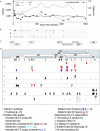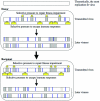Selection on the human immunodeficiency virus type 1 proteome following primary infection
- PMID: 16973556
- PMCID: PMC1617227
- DOI: 10.1128/JVI.00575-06
Selection on the human immunodeficiency virus type 1 proteome following primary infection
Abstract
Typically during human immunodeficiency virus type 1 (HIV-1) infection, a nearly homogeneous viral population first emerges and then diversifies over time due to selective forces that are poorly understood. To identify these forces, we conducted an intensive longitudinal study of viral genetic changes and T-cell immunity in one subject at < or =17 time points during his first 3 years of infection, and in his infecting partner near the time of transmission. Autologous peptides covering amino acid sites inferred to be under positive selection were powerful for identifying HIV-1-specific cytotoxic-T-lymphocyte (CTL) epitopes. Positive selection and mutations resulting in escape from CTLs occurred across the viral proteome. We detected 25 CTL epitopes, including 14 previously unreported. Seven new epitopes mapped to the viral Env protein, emphasizing Env as a major target of CTLs. One-third of the selected sites were associated with epitopic mutational escapes from CTLs. Most of these resulted from replacement with amino acids found at low database frequency. Another one-third represented acquisition of amino acids found at high database frequency, suggesting potential reversions of CTL epitopic sites recognized by the immune system of the transmitting partner and mutation toward improved viral fitness in the absence of immune targeting within the recipient. A majority of the remaining selected sites occurred in the envelope protein and may have been subjected to humoral immune selection. Hence, a majority of the amino acids undergoing selection in this subject appeared to result from fitness-balanced CTL selection, confirming CTLs as a dominant selective force in HIV-1 infection.
Figures


References
-
- Achaz, G., S. Palmer, M. Kearney, F. Maldarelli, J. W. Mellors, J. M. Coffin, and J. Wakeley. 2004. A robust measure of HIV-1 population turnover within chronically infected individuals. Mol. Biol. Evol. 21:1902-1912. - PubMed
-
- Addo, M. M., X. G. Yu, A. Rathod, D. Cohen, R. L. Eldridge, D. Strick, M. N. Johnston, C. Corcoran, A. G. Wurcel, C. A. Fitzpatrick, M. E. Feeney, W. R. Rodriguez, N. Basgoz, R. Draenert, D. R. Stone, C. Brander, P. J. Goulder, E. S. Rosenberg, M. Altfeld, and B. D. Walker. 2003. Comprehensive epitope analysis of human immunodeficiency virus type 1 (HIV-1)-specific T-cell responses directed against the entire expressed HIV-1 genome demonstrate broadly directed responses, but no correlation to viral load. J. Virol. 77:2081-2092. - PMC - PubMed
-
- Allen, T. M., M. Altfeld, S. C. Geer, E. T. Kalife, C. Moore, K. M. O'Sullivan, I. DeSouza, M. E. Feeney, R. L. Eldridge, E. L. Maier, D. E. Kaufmann, M. P. Lahaie, L. Reyor, G. Tanzi, M. N. Johnston, C. Brander, R. Draenert, J. K. Rockstroh, H. Jessen, E. S. Rosenberg, S. A. Mallal, and B. D. Walker. 2005. Selective escape from CD8+ T-cell responses represents a major driving force of human immunodeficiency virus type 1 (HIV-1) sequence diversity and reveals constraints on HIV-1 evolution. J. Virol. 79:13239-13249. - PMC - PubMed
-
- Allen, T. M., M. Altfeld, X. G. Yu, K. M. O'Sullivan, M. Lichterfeld, S. Le Gall, M. John, B. R. Mothe, P. K. Lee, E. T. Kalife, D. E. Cohen, K. A. Freedberg, D. A. Strick, M. N. Johnston, A. Sette, E. S. Rosenberg, S. A. Mallal, P. J. Goulder, C. Brander, and B. D. Walker. 2004. Selection, transmission, and reversion of an antigen-processing cytotoxic T-lymphocyte escape mutation in human immunodeficiency virus type 1 infection. J. Virol. 78:7069-7078. - PMC - PubMed
-
- Allen, T. M., X. G. Yu, E. T. Kalife, L. L. Reyor, M. Lichterfeld, M. John, M. Cheng, R. L. Allgaier, S. Mui, N. Frahm, G. Alter, N. V. Brown, M. N. Johnston, E. S. Rosenberg, S. A. Mallal, C. Brander, B. D. Walker, and M. Altfeld. 2005. De novo generation of escape variant-specific CD8+ T-cell responses following cytotoxic T-lymphocyte escape in chronic human immunodeficiency virus type 1 infection. J. Virol. 79:12952-12960. - PMC - PubMed
Publication types
MeSH terms
Substances
Grants and funding
LinkOut - more resources
Full Text Sources
Other Literature Sources
Medical

